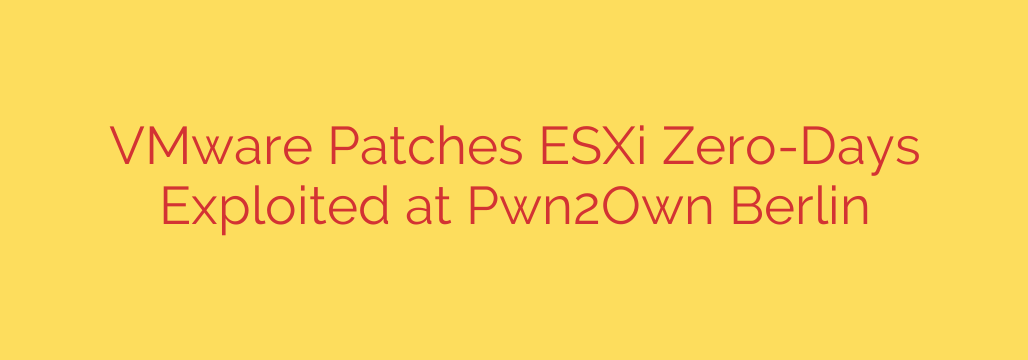
Critical VMware Patches Released: Secure Your ESXi Hosts Now to Prevent VM Escape
VMware has released urgent security updates to address several critical vulnerabilities in its ESXi hypervisors, Workstation, and Fusion products. These flaws could allow an attacker to escape from a guest virtual machine (VM) and execute malicious code on the underlying host system—a severe security breach known as a VM escape.
System administrators and security teams are strongly advised to apply these patches immediately to protect their virtualized environments from potential compromise. The vulnerabilities were successfully demonstrated at the Pwn2Own Berlin 2024 hacking competition, confirming their practical exploitability.
Understanding the Critical Flaws: CVE-2024-22252 and CVE-2024-22253
The most severe issues addressed are two use-after-free vulnerabilities found in the XHCI and UHCI USB controllers. Tracked as CVE-2024-22252 and CVE-2024-22253, both flaws carry a critical CVSS severity score of 9.3.
Here’s what makes them so dangerous:
- An attacker who has already gained local administrative privileges on a guest virtual machine can exploit these vulnerabilities.
- Successful exploitation allows the attacker to break out of the sandboxed VM environment.
- This enables them to execute arbitrary code as the VMX process on the host server, effectively achieving a full VM escape.
These vulnerabilities put the entire host server at risk, undermining the fundamental security promise of virtualization.
The Threat of a VM Escape: A Major Security Breach
A “VM escape” is one of the most significant threats in a virtualized environment. Virtualization is designed to isolate each virtual machine in its own secure container, preventing it from interacting with the host or other VMs on the same hardware.
A VM escape completely shatters this isolation. By breaking out of the guest environment, an attacker gains control over the hypervisor or host operating system. This grants them the ability to:
- Compromise all other VMs running on the same host.
- Access and exfiltrate sensitive data from the host and other guest machines.
- Establish a persistent foothold within the corporate network.
- Deploy ransomware or other malware across the infrastructure.
Because one compromised VM can lead to the takeover of an entire server, patching these vulnerabilities is a top priority.
Additional Flaws Addressed in the Update
Beyond the critical VM escape flaws, the security update also patches two other important vulnerabilities:
- CVE-2024-22254: An out-of-bounds write vulnerability that could lead to a sandbox escape from the VMX process. This flaw is rated as “Important” with a CVSS score of 7.9.
- CVE-2024-22255: An information disclosure vulnerability in the UHCI controller. This could allow an attacker to leak memory from the VMX process to a virtual machine, potentially exposing sensitive information. It is rated “Important” with a CVSS score of 7.1.
While less severe than the VM escape flaws, these vulnerabilities were chained together by security researchers to achieve the full system compromise at Pwn2Own, highlighting the importance of comprehensive patching.
Immediate Action Required: How to Secure Your Systems
Given the critical nature of these vulnerabilities and their proven exploitability, immediate action is necessary. There are no known workarounds to mitigate these flaws; applying the official patches is the only solution.
Follow these steps to secure your environment:
Identify Affected Systems: The vulnerabilities impact a wide range of VMware products. Review your inventory for the following:
- VMware ESXi
- VMware Cloud Foundation (VCF)
- VMware Workstation Pro & Player (for Windows and Linux)
- VMware Fusion Pro & Fusion Player (for macOS)
Apply Patches Immediately: Prioritize patching your ESXi hosts, as they are the most critical infrastructure components. Refer to VMware’s security advisory VMSA-2024-0006 for specific patch versions and download links corresponding to your product versions.
Implement Security Best Practices: While patching is essential, reinforce your security posture by:
- Restricting administrative access within virtual machines to only trusted users.
- Monitoring host and guest systems for any unusual or suspicious activity.
- Ensuring your overall network segmentation and security controls are robust to limit the potential impact of a breach.
Staying ahead of threats requires constant vigilance. Proactive patch management is the cornerstone of a robust virtualization security strategy, and addressing these critical flaws should be at the top of every administrator’s to-do list.
Source: https://www.bleepingcomputer.com/news/security/vmware-fixes-four-esxi-zero-day-bugs-exploited-at-pwn2own-berlin/








